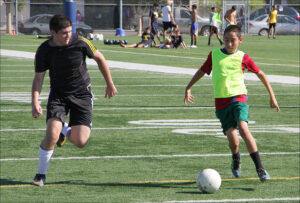
SMMUSD HDQTRS — Santa Monica-Malibu Unified School District students continued to outperform their state and county peers in almost every category in physical fitness test results released last week, but many still fall short of the standards.
The Physical Fitness Test, administered in the beginning of each calendar year, looks at aerobic capacity, body composition, abdominal strength, trunk extension strength, upper body strength and flexibility.
Students in fifth, seventh and ninth grades across the state take the exam, which breaks kids down in to three groups, depending on the test — "Healthy Fitness Zone," needs improvement and high risk.
To be physically fit, students need to score within the Healthy Fitness Zone in each of the six categories.
Only 31 percent of the 1.3 million students statewide that took the test qualify as fit, according to a release from the California Department of Education. That's the same as last year.
"When we can call fewer than one out of three of our kids physically fit, we know we have a tremendous public health challenge on our hands," said Tom Torlakson, state superintendent of Public Instruction.
That number was significantly better for Santa Monica-Malibu students, with 43.5 percent of students qualifying as fit compared to 39 percent in the 2010-11 year.
A higher percentage of SMMUSD students were in the Healthy Fitness Zone in each of five categories compared to their state counterparts with the exception of flexibility amongst seventh grade students, according to the test results.
Ninth graders also improved in almost every category compared to last year's results, said Bertha Roman, the teacher on special assignment with the Physical Education Department.
High school officials have been pushing to make sure each test is completed correctly and on time, she said, which accounts for some of the increase in the scores.
"They're really focusing on aspects of the test and preparing students to take the test," she said. "Prep is key for that, as well as making sure every student is accounted for."
Being active is one thing, but it actually takes practice to accomplish some of the tests, like running a mile in a certain time or performing exercises like curl-ups with precision.
"There was a push to get kids familiarized with the test," Roman said.
Some things you can't practice for, however.
Body composition, the ratio of fat to muscle and other tissues of the body, is considered the most important indicator of future health, according to the state release.
By that measure almost a third of fifth and seventh grade kids across the state are "high risk" in terms of their body composition, and 25.3 percent of ninth graders also fall into that category.
Just under 20 percent of SMMUSD students in all three grades are "high risk." Those numbers fell in 2011-12 for fifth and seventh graders, but climbed almost two percentage points for ninth graders.
Those numbers look a bit different when broken down by racial groups.
Only 16.1 percent of African-American fifth graders who took the test were "high risk," although numbers for seventh and ninth graders were a little bit above the district average.
Latino students, however, showed much higher numbers, with 36.5 percent of fifth graders, 31.4 percent of seventh graders and 29.6 percent of ninth graders considered "high risk."
In general they scored lower than the district average in almost every category but flexibility and trunk extensions.
Asian students tend to score higher than average, and white students are either above or just below the district average.
Physical fitness is one of a series of factors considered in the new Santa Monica Youth Wellbeing Report Card that debuted in October. The report card is meant to establish a baseline measurement of overall well-being amongst Santa Monica's young people so that officials at City Hall, the school district and dozens of nonprofits can work together to improve their quality of life.
Activity is critical for children's health now and when they become adults, said Denise Sur, chief of staff at the UCLA-Santa Monica Medical Center.
Exercise can prevent diabetes, heart problems and even some forms of cancers. Physical activity can also improve focus in children and adults, meaning that children may learn better after they've been physically active.
"It's interesting that you don't see more of a reaction to that from parents," Sur said. "You'd think they would be outraged, nervous or frightened about their kids' future."
If children are inactive now, it will be harder for them to get active later in life, she said.
Obesity can lead to heart problems, diabetes, asthma, sleep apnea and social discrimination.
City Hall tries to make physical fitness a priority for kids by aggressively marketing after-school and summer activities to keep them active and engaged, said Julie Rusk, assistant director of Community & Cultural Services at City Hall.
That effort is paired with financial assistance for those of lower socio-economic status who otherwise couldn't afford them, Rusk said.
Overall, the improved and stable scores show the impact of those programs and targeted work at schools.
"We certainly expect that given the many programs and initiatives in place," Rusk said. "These are kids living in a community that does more in the summer and after school."
Childhood fitness and obesity have come under the spotlight nationwide in recent years. First Lady Michelle Obama launched the Let's Move! initiative to target the problem, and President Barack Obama created the first-ever Task Force on Childhood Obesity to develop and implement a plan to end the disease within a generation.
ashley@www.smdp.com









